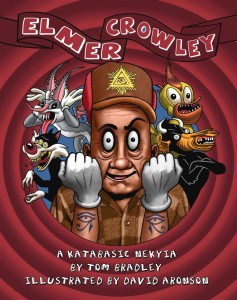A Katabasic Nekyia
Tom Bradley
(illustrated by David Aronson & Nick Patterson)

Elmer Crowley / USA & AUS / $22.00
Elmer Crowley
A Katabasic Nekyia
Tom Bradley, David Aronson, Nick Patterson.
Format: Softcover/132 pp – illustrated – many in colour.
ISBN: 978-1-906958-55-8
US $22.00 / UK £15.00
Subjects: Aleister Crowley & Thelema/picaresque graphic novel.
In Elmer Crowley, Tom Bradley dismantles and re-welds biography, novel, creative non-fiction and metaphysical treatise into a bizarre satire. Aleister Crowley, alias ‘The Anti-Christ’, has bungled his karma and ended up the Looney Tune character Elmer Fudd.
The whole outlandish premise plays out as a mockery of occultism’s darkest delusions. The subtitle means a descent into a ritual by which ghosts are invoked to divine the future.
The narrator is the incarnated ghost of Crowley. He and Hitler are sometimes compared for the similarities of their occult-based belief in “Do As Thou Wilt” as justification for turning hapless followers into “stringless marionettes.” Crowley’s opening words refer to Hitler as his “magickal child,” setting the moral tone for what follows. Numerous themes branch out from this initial assertion with key scenes wickedly illustrated, adding ‘graphic novel’ as yet another misleading describer of Bradley’s furcated katabasis.
Crowley, Fudd, Hitler, Buddha, Yeats, Heliopolitan hierophants, the Goddess Baubo, assorted “Nilotic dream despots”, a carrot-eating Madame Blavatsky, Bugs Bunny, Daffy Duck and their Warner Brothers producer, Leon Schlesinger bounce and boing their way across human history. These are the launch points for Bradley’s inquiries into questions of meta-ethics and truth against a background of “Esoteric Hitlerists.”
Crowley’s tragic flaw is his fixed idea that “magick is done to the strains of incantatory monotony, not self-conscious art.” This translates into control of non-questioning followers to serve his ends, noting with admiration that the A-bomb is “the most magickal blackjack to come swinging along since the sage Aurva armed his king with the fire missile in the Vishnu Purana.”
Crowley and Fudd share a speech defect: the inability to pronounce the R sound (“that wascal wabbit”). “Many fine magi,” Crowley claims, “perhaps even a slim majority… are poorly spoken.” That would include (besides Buddha and Hitler’s doctor) Leon Schlesinger, the money behind the Warner Brothers cartoons. Crowley and Schlesinger meet at a Hollywood orgy over a shared pederastic interest in a youth who also has a speech impediment. Whether Elmer Fudd’s “babbling weakness” on screen is a gibe at Crowley’s lisp is something the reader will have to determine. Either way, reincarnation as a lisping Looney is not an inapt destiny for the Anti-Christ who infamously wrote in his Confessions, “direct injury [is] the proper conjuration to call up gratitude.”
Doing as one wills, central to Crowley’s philosophy of Thelema, easily leads to a perverted will to power. Crowley realises after it’s too late that his magick act stinks. “Is ‘wayward sorcery’ a damnation offence as [Madame Blavatsky] proclaimed?” All you need is love, not will. As Bradley has stated elsewhere, “The universe runs on a Theosophical rather than a Thelemic dispensation.”
Elmer Crowley may confound those who want their words to move through books like soldiers in formation and come to a uniform halt at the end. But readers willing to navigate outside the usual throughways will find themselves in the higher vistas of this rich and complex tome, slim enough for the slow and multiple readings it deserves. – John-Ivan Palmer
REVIEWS:
Reading Elmer Crowley is like reading Crowley’s inner dialogue at 3am, after an intensive journey into his own inner abyss. It is, therefore, a magickal working that Crowley himself would be proud of.
– Gwendolyn von Taunton, author of Northern Traditions
Of Aleister Crowley’s many fictionalizations, this novel gets best into his head. Erudite, prideful, lascivious, funniest man of his time, and the mightiest spiritual spelunker–he speaks and shouts from these pages as clearly as he did in his Autohagiography, which is paradoxical, given the irreal setting.
– Barry Katz, HTMLGIANT
This book…captures the feel of Crowley with his bawdy, politically incorrect irreverence, his arrogance and his committed magickal spirituality and awareness.
– Charlotte Rogers, author of P is for Prostitute
The voice is dead perfect…I can’t imagine a hip Thelemite NOT having this book in her library.
– Don Webb, author of Through Dark Angles, former High Priest, Temple of Set
This self-described “picaresque graphic novel” reads like an account of Crowley’s death-bed fever dream or an afterlife bardo journey gone terribly wrong, wherein the fifty-eight Wrathful Deities take on the aspect of warped and sinister versions of Looney Toons archetypes…. the result reads like a trippy, post-mortem, long-lost epilogue to The Confessions.
– Richard Kaczynski, author of Perdurbo: The Life of Aleister Crowley

